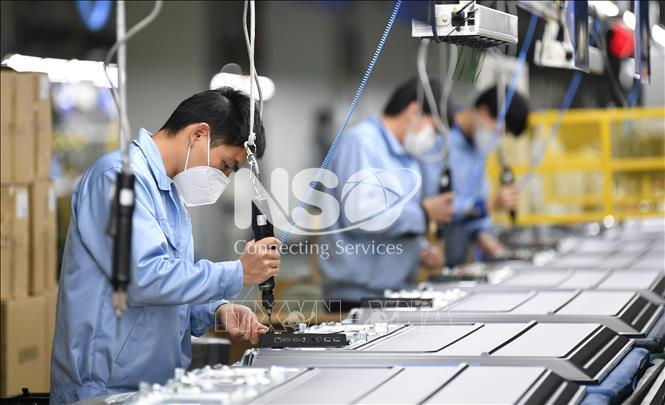
In a recent article about FDI prospects in the ASEAN region published in Singapore's The Business Times, Mr. Sam Cheong - Head of FDI consulting team and partner network at Singapore-based UOB bank - said capital flows Globally, foreign direct investment (FDI) has been hit harder by the Covid-19 pandemic than the 2008-2009 global financial crisis.
According to the World Investment Report 2021 of the United Nations Conference on Trade and Development (UNCTAD), global FDI inflows fell by a third from $1.5 trillion in 2019 to $1 trillion in 2020. In fact , FDI inflows in 2020 are 20% lower than in 2009 when blockades to prevent the spread of the Covid-19 epidemic took place in many countries and the prospect of an economic downturn caused many companies across the world must reevaluate their investment plans.
However, according to Sam Cheong's research, despite the economic impact of the Covid-19 pandemic, Asia remains an attractive destination for FDI inflows. The UNCTAD report shows that FDI inflows into Asia in 2020 will increase by 4% to US$533 billion. In which, investment inflows into China reached 149 billion USD, up from 141 billion USD in 2019.
FDI growth in Asia is forecast to continue to increase by 5-10% year-on-year in 2021. According to the UNCTAD report, this increase is driven by developing economies, linked Regional and global linkages are deepening and the investment environment in the region has generally remained accommodative despite the pandemic.
Particularly for the ASEAN region, the author said that FDI inflows into the region in 2020 have decreased slightly. The countries attracting the most FDI in ASEAN all recorded declines such as Singapore down 21%, Indonesia down 22%, Vietnam down 2%. However, these three countries still account for more than 90% of the region's FDI inflows in 2020.
In 2019, FDI into Thailand reached about 3 billion USD. However, this figure has turned negative 6 billion USD in 2020 due to foreign investors divestment. Meanwhile, Malaysia dropped 55% to 3 billion USD; Myanmar fell 34% to $1.8 billion. However, The Business Times said that the outlook for ASEAN economies remains bright. The signing of the Regional Comprehensive Economic Partnership (RCEP), which includes all ASEAN member states, China, Japan, South Korea, Australia and New Zealand, is expected to be one of the most exciting events. the main growth force as this trade bloc deepens its economic integration.
According to the author, capital inflows into energy infrastructure projects globally in 2020 fell 40% to $27 billion, the lowest in 8 years. But that seems to be the exception for Asia. Asia is the only region where energy infrastructure projects have grown in both quantity and value. For example, in Vietnam, the author said that in 2020, ExxonMobil Corporation of the US has proposed to invest in a $5 billion gas-fired power plant in Hai Phong while Delta Offshore Energy Group (Singapore) would also set up a $4 billion LNG power generation facility in Bac Lieu.
Despite the decline in global spending, FDI in renewable energy projects still increased, from 30.7 billion USD in 2019 to 33.4 billion USD in 2020. Of which, FDI in Renewable energy projects in ASEAN will also increase further as the region commits to considering and transitioning energy towards sustainability. B.Grimm, a private Thai electricity producer, has invested in construction. a solar power plant in Tay Ninh province, considered one of the largest solar power plants in the region. Similarly, Impact Electrons Siam is also developing a wind farm in Laos. This will be the largest wind power project in ASEAN.
According to Mr. Sam Cheong's article, the majority of FDI investment of ASEAN enterprises is still located in the region. Intra-regional FDI inflows increased by 5.4%, from 22.1 billion USD in 2019 to 23.3 billion USD in 2020. Of which, Singapore and Thailand are the two largest investors in ASEAN in 2020. In fact, companies from Singapore have formed the largest investor group in several countries. Singaporean investors account for 25% of FDI in Indonesia and 40% of FDI in Vietnam. According to Enterprise Singapore, companies from the island nation have invested in Indonesian consumer products and services, manufacturing, transportation, logistics and infrastructure.
Similar to Singapore, in 2020, FDI inflows of Thai investors also doubled to 17 billion USD. In which, 85% of the country's FDI is concentrated in industries such as financial services, retail, wholesale, manufacturing, real estate and construction activities in ASEAN.Indonesia and the Philippines also invest in the region. with capital of 4.5 billion USD and 3.5 billion USD respectively. For example, Japfa Comfeed Group (Indonesia) has opened an animal feed factory in Vietnam while Ayala Group (Philippines) and its Singaporean partner are also building a wind farm in Vietnam.
In conclusion, the author said, while the overall outlook of ASEAN countries depends on how well countries contain the pandemic, intra-regional investment will promote not only stronger economic cooperation, but also bring economic benefits. long-term growth prospects for the bloc.
Source Dan Tri